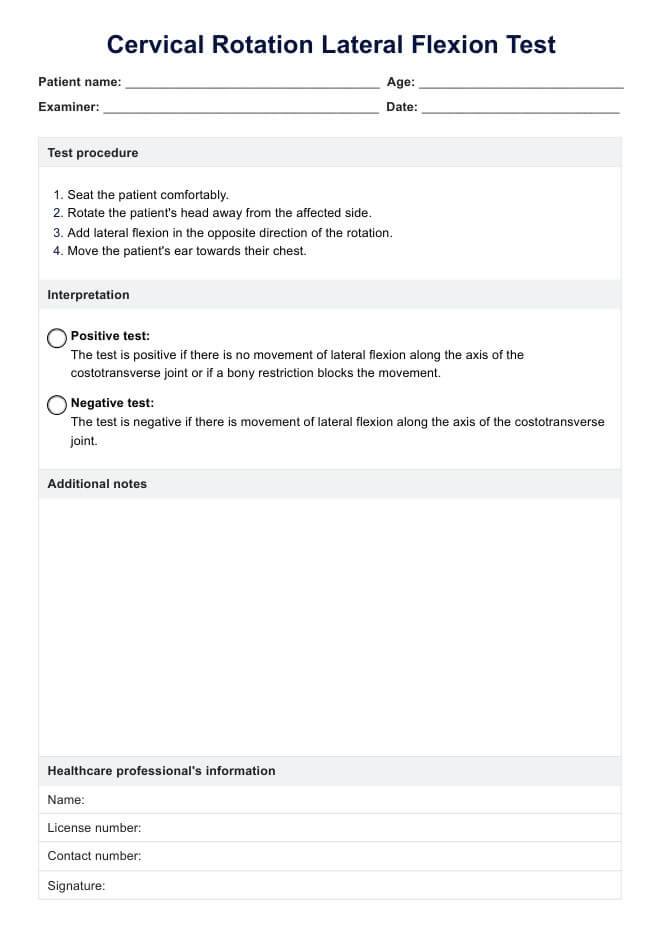Cervical Rotation Lateral Flexion Test
Learn about the cervical rotation lateral flexion test, its importance, how it is performed, and download Carepatron's free PDF example for reference.


What is thoracic outlet syndrome?
Thoracic outlet syndrome (TOS) is a term used to describe a group of conditions that occur when there is compression or irritation of the nerves, blood vessels, or muscles in the thoracic outlet area. The thoracic outlet is the space between your collarbone (clavicle) and first rib.
TOS can be classified into three types based on the underlying cause: neurogenic TOS, arterial TOS, and venous TOS. Neurogenic TOS is the most common type and occurs when there is compression of the brachial plexus, a network of nerves that control movement and sensation in the shoulder, arm, and hand. Arterial TOS occurs when the subclavian artery, which supplies blood to the arms, is compressed or narrowed. Venous TOS occurs when the subclavian vein, which carries blood from the arms back to the heart, is compressed or blocked.
Symptoms
The symptoms that indicates thoracic outlet syndrome can vary but often include:
- Neck pain: Persistent or sharp pain in the neck, often worsened by certain movements.
- Shoulder pain: Discomfort or pain extending to the shoulder area.
- Arm pain: Pain radiating down the arm, which can be accompanied by tingling or numbness.
- Weakness: Reduced strength in the arm or hand, making it difficult to perform daily tasks.
- Reduced range of motion: Limited ability to rotate or flex the neck.
- Headaches: Tension headaches stemming from neck issues.
- Swelling: In some cases, swelling in the affected area.
Causes
The causes indicating thoracic outlet syndrome often involve a combination of factors. Anatomical abnormalities, such as an extra cervical rib or a tight fibrous band connecting the spine to the first rib, can lead to compression in the thoracic outlet. Poor posture, particularly prolonged poor posture, can exacerbate this compression.
Repetitive activities that require continuous shoulder movement, such as lifting or typing, are common contributors. Trauma, like a car accident or sports injury, can also trigger symptoms. Additionally, cervical spine rotation and first and second rib anomalies can cause nerve compression, leading to thoracic outlet syndrome. Congenital defects may also predispose individuals to this condition.
Cervical Rotation Lateral Flexion Test Template
Cervical Rotation Lateral Flexion Test Template
What is the Cervical Rotation Lateral Flexion Test?
The Cervical Rotation Lateral Flexion Test is a clinical examination technique used to assess the range of motion in the cervical spine. It is primarily used to evaluate the function and mobility of the neck, specifically looking at rotation and lateral flexion movements.
The test involves having a patient sit comfortably with their head in a neutral position. The examiner then rotates the patient's head to one side, while simultaneously tilting it towards that same shoulder. This movement is repeated on both sides.
A positive test is indicated by limited or painful range of motion, which may suggest a neck injury or underlying condition such as arthritis or muscle strain. The results of this test can help guide treatment and rehabilitation plans for patients.
Next steps after conducting this test
After conducting the Cervical Rotation Lateral Flexion Test, the next steps typically involve analyzing the results to guide further treatment. If the test indicates restricted lateral flexion or cervical spine rotation, the practitioner may recommend specific interventions. These could include targeted thrust manipulation to address upper rib or first rib issues identified during the test.
Diagnostic imaging, such as cineradiography, might be used to confirm findings, especially in cases where brachialgia is present. Overall, the test helps in formulating a tailored treatment plan to alleviate neck pain and improve functional outcomes for the patient.
How to use our Cervical Rotation Lateral Flexion Test template
Our Cervical Rotation Lateral Flexion Test template provides a structured approach for medical professionals to conduct this physical examination:
Access the template
Accessing the template is straightforward. Simply log in to your Carepatron account and go to our Resource Library for the template.
Review the test
Review the template to familiarize yourself with the steps involved in conducting the test. Ensure you understand the specific instructions for positioning the patient, conducting the movements, and interpreting the results.
Use the template to test the patient
Follow the step-by-step instructions provided in the template to perform the cervical rotation lateral flexion test on your patient. Document any observations or limitations noted during the test accurately.
Provide results to the patient
After completing the test, use the template to record and summarize the results clearly. Discuss the findings with the patient, explaining any restrictions or abnormalities observed during the test.
Discuss next steps for monitoring and follow-up
Utilize the template to outline the next steps for monitoring the patient's progress and planning follow-up appointments or treatments as needed. Ensure the patient understands the recommended course of action based on the test results.
Commonly asked questions
Cervical lateral flexion is typically measured using a goniometer or by observing the patient's ability to laterally bend the neck towards the shoulder while seated or standing.
Upper rib manipulation involves the manual adjustment of the first and second ribs, which are closely associated with the cervical spine. This treatment can help alleviate symptoms of restricted neck movement and associated discomfort by addressing the mechanical dysfunction in this area.
Yes, thrust manipulation targeting the upper ribs can improve neck-related disability by restoring normal movement and reducing pain and stiffness. This technique has been shown to enhance the overall function of the cervical spine, which can significantly impact a patient's ability to perform daily activities.
Manual examination is crucial in clinical practice for accurately diagnosing and treating cervical spine issues. Through hands-on assessment, clinicians can identify specific areas of dysfunction, determine the severity of the condition, and develop a tailored treatment plan. This approach ensures that interventions like manipulation and mobilization are applied effectively to improve patient outcomes.







































































































